| CONSTANCE MEYER Articles |
|
The English horn: A mournful cry of 'ahhh'
The curvy instrument requires its player to pack a lot of wind -- the better to produce those sad sounds. And watch out for the razor blades. September 12, 2004 | by Constance Meyer | The Los Angeles Times Decades ago, Ripley's Believe It or Not clued readers in about the English horn. The instrument, it declared, is "neither English nor a horn." In fact, there's little agreement about where the name of this double-reed woodwind, a member of the oboe family, came from -- only consensus that it's a misnomer. Good luck if you query an Englishman about it. Show him a picture and he might well correct you: "Oh, you mean the cor anglais."
Certainly many people recognize the oboe, straight and black with its silver keys, when it plays an A so the members of the orchestra can tune their instruments. Far fewer listeners can distinguish its curvy cousin. To cognoscenti, though, the English horn's sound -- its urgent plangency -- is bolder, deeper, richer. "A brass player uses a mouthpiece," Hove says, "then buzzes his lips. With the double-reed instruments, it's the two reeds vibrating against each other between the lips and the airstream that make the tone."
Curve makes a difference At first glance, the English horn resembles an overgrown oboe. But it has two things an oboe doesn't: First there's the bell shape at the bottom, which looks, if you've spent any time around school science labs, like the bulge in a snake that has recently devoured a mouse. Second is the reed holder -- the bocal (rhymes with "vocal"). Hove describes it as a "little angled metal tube, smaller at the top, a little larger as it goes down. It's got a curve to it and some cork around the outside of the bottom, which goes into the reed well." "This curve is one of the things that changes the sound," she explains, "as opposed to the oboe, which is a straight shot."
Conversely, not all oboists learn to play the English horn because, as Gilad notes, "it's quite a bit heavier, and they find it uncomfortable. Some people get tendinitis in their arms, so they specialize on oboe and audition for those jobs." And some English horn specialists, like Stuart Horn, feel "constricted" playing the oboe. Although the busy Horn won a Grammy this year on oboe with Southwest Chamber Music in the small ensemble performance category, "with the English horn," he says, "I feel I can sing."
"I was always attracted to strange, obscure instruments," he adds, but "the high school didn't even own an English horn because there was no one who could play it." He finally got his hands on one when he went to study at the New England Conservatory of Music in Boston, where he also found that "oboe players could be very arrogant: 'Play the English horn? Certainly not.' " The result? "They stayed home -- and I worked."
Hove, whose mother was a violinist, notes that string players don't have "wind" issues. "They can play on for pages and pages. We can't do that. We have to breathe and give our embouchure a chance to recover. You have to let these muscles" -- she touches her lips and the facial and jaw muscles used to blow into the instrument -- "time to relax before you can go on." But the slogan on one of Stuart Horn's T-shirts -- "Got reed?" -- pinpoints the biggest hassle for double-reed players. As Hove puts it: "We spend millions of hours at our reed desks." Gilad explains: "Reeds are made out of bamboo, which has to be split, gouged, shaped and scraped so this little piece of cane can vibrate. And it needs to be wet to do that." Says Hove: "The cane starts out at around 4 inches long. Then we fold it over so it becomes half as long, tie it onto the tube, scrape and clip and so on. I know some players who can have a television on, or listen to music. I can't. I have to be completely focused on what I'm doing. "We've all gotten cut," she adds. "We use single-edge razor blades and sharp knives. But you learn."
"We swab out the hot air that we're blowing in, which creates moisture, so the moisture doesn't crack the wood," Gilard says. Elardo stopped using her purple swab after it got stuck in her instrument once too often. These days, she "swabs out" with a turkey feather. The price of a top-quality English horn is about $10,000. Hove says that "while it's cheap compared to a stringed instrument" -- a Stradivarius can fetch millions -- "we have to have more than one, and they wear out. Unlike stringed instruments that appreciate with the years, ours depreciate and get damaged with use, so you're constantly looking to replace instruments."
It's a workout
Composers also have not written consistently for the instrument. Although in his choral music Bach wrote gorgeous solos for its predecessor, the oboe da caccia -- as well as for the English horn -- the latter was all but completely ignored throughout the Classical period. Only one of Haydn's 100-plus symphonies, "The Philosopher," calls for it. "You didn't find it in Brahms, Beethoven, Mendelssohn or Schumann," Hove says. By contrast, Berlioz, who included a number of formerly marginalized instruments in his broadening of symphonic orchestration, "used the English horn on a regular basis. Debussy, Ravel, Stravinsky, Wagner and Richard Strauss wrote a lot for the English horn, as did many of the 20th century composers."
For Elardo, the tone of the English horn is "plaintive. So many of the solos are gut wrenching, 'let it all hang out.' I guess I'm real good at that. I'm half Italian-Spanish and half Russian Jew. All my life, I always poured all my emotion into the instrument, and English horn just seems to accept it better. I can't say why. Part of it is the repertoire, part of it is the color, and part of it is that it's more flexible in a way that the oboe isn't." Any hard feelings between the oboe and the English horn camps? Elardo sighs. "That's the sad part. Oboe players work their butts off. They play everything, and the English horn player sits there all night, plays an eight-bar solo, and everybody just goes, 'Ahhhh.' "
|
|
The following pictures appeared in the Los Angeles Times with this article by Constance Meyer:
|
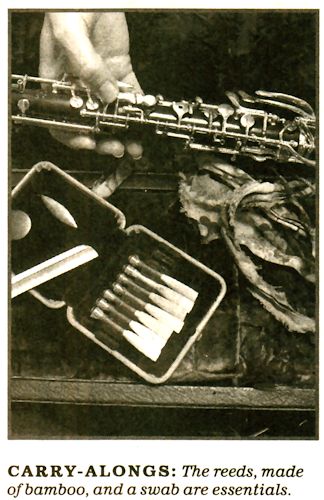 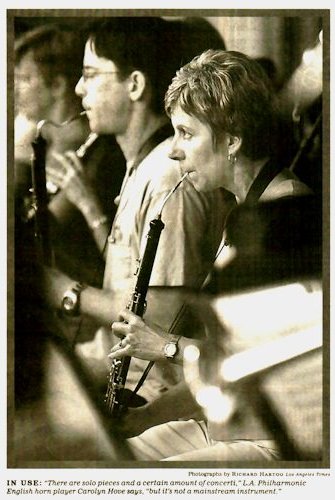
|
|
Copyright 2004 Constance Meyer. All rights reserved
|
|
|
|
|
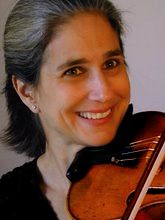
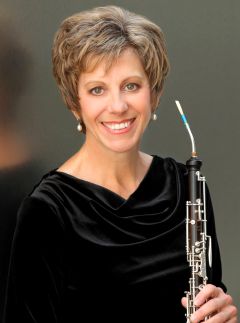 But as
Carolyn Hove, the English horn player with the Los Angeles Philharmonic, says with a laugh: "It wouldn't take much for
cor angle" -- a possible reflection in French that the instrument was originally angled to
make playing it on horseback easier -- "to become cor anglais. It's probably one of those evolution things, where one thing led to another and it's just one giant misunderstanding."
But as
Carolyn Hove, the English horn player with the Los Angeles Philharmonic, says with a laugh: "It wouldn't take much for
cor angle" -- a possible reflection in French that the instrument was originally angled to
make playing it on horseback easier -- "to become cor anglais. It's probably one of those evolution things, where one thing led to another and it's just one giant misunderstanding."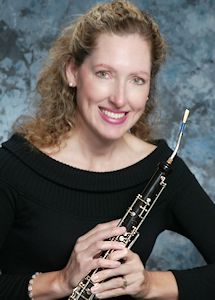 Oboist and English hornist
Kim Gilad, a member of the Los Angeles Chamber Orchestra and a busy freelancer, notes that in film
scores, the English horn is "usually used in sad, mysterious or poignant scenes, much the way the sax is used in sexy ones."
Oboist and English hornist
Kim Gilad, a member of the Los Angeles Chamber Orchestra and a busy freelancer, notes that in film
scores, the English horn is "usually used in sad, mysterious or poignant scenes, much the way the sax is used in sexy ones."
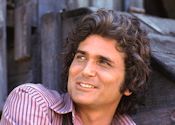 To
Earle Dumler, who plays oboe and English horn with Los Angeles Opera, the sound is "mournful." Dumler remembers the late actor-producer
Michael Landon's
words to him at a Christmas party for TV's "Little House on the Prairie," on which he played for 11 years: "Earle, as long as they're crying and dying, you'll be working."
To
Earle Dumler, who plays oboe and English horn with Los Angeles Opera, the sound is "mournful." Dumler remembers the late actor-producer
Michael Landon's
words to him at a Christmas party for TV's "Little House on the Prairie," on which he played for 11 years: "Earle, as long as they're crying and dying, you'll be working." The English horn's greater heft, it turns out, is part of its appeal to many players: Specialists refer to the comfort of its size. Whereas the soprano-voiced oboe is petite, its tenor-voiced relative,
pitched five notes lower, is a better fit in certain musicians' hands.
The English horn's greater heft, it turns out, is part of its appeal to many players: Specialists refer to the comfort of its size. Whereas the soprano-voiced oboe is petite, its tenor-voiced relative,
pitched five notes lower, is a better fit in certain musicians' hands.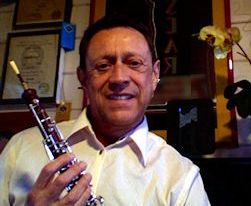 Still, many orchestras don't have an English horn chair; the second oboist simply "doubles" on the instrument.
(Earle)
Dumler, for example, hails from a small town in Kansas where, he says, "two things were big in the
school system -- basketball and music." At the beginning of sixth grade, he recalls, he was asked what instrument he wanted to learn. His confident reply: "Oboe." Thus he was perplexed when the teacher
"came out with a little case. I had it confused in my mind with the bassoon. But I was much too proud to admit my error, so I stuck with it.
Still, many orchestras don't have an English horn chair; the second oboist simply "doubles" on the instrument.
(Earle)
Dumler, for example, hails from a small town in Kansas where, he says, "two things were big in the
school system -- basketball and music." At the beginning of sixth grade, he recalls, he was asked what instrument he wanted to learn. His confident reply: "Oboe." Thus he was perplexed when the teacher
"came out with a little case. I had it confused in my mind with the bassoon. But I was much too proud to admit my error, so I stuck with it. Joan Elardo
Joan Elardo More so than the oboe, though, playing the
More so than the oboe, though, playing the
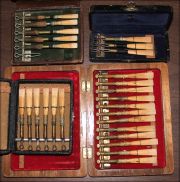 The reeds -- which have a performing life comparable to that of toe shoes -- need to be moist for an English hornist to play well, and these musicians' "space" onstage reveals a fair amount of additional
paraphernalia not only to produce moisture but to then extract it from their instruments. To soak his reeds, Horn takes a thermos with "warmish water" that he places with other tools under his seat; some players
use a 2-inch film canister. Most players also routinely run a delicate silk scarf, a "swab," through their instruments.
The reeds -- which have a performing life comparable to that of toe shoes -- need to be moist for an English hornist to play well, and these musicians' "space" onstage reveals a fair amount of additional
paraphernalia not only to produce moisture but to then extract it from their instruments. To soak his reeds, Horn takes a thermos with "warmish water" that he places with other tools under his seat; some players
use a 2-inch film canister. Most players also routinely run a delicate silk scarf, a "swab," through their instruments. On the other hand, there are, by general agreement, only two important oboe and English horn makers. As with Coke and Pepsi, you're in one camp or the other. Dumler, Gilad and Horn play instruments made by
On the other hand, there are, by general agreement, only two important oboe and English horn makers. As with Coke and Pepsi, you're in one camp or the other. Dumler, Gilad and Horn play instruments made by
 One of the difficulties of writing a concerto for English horn, Hove says, is "the issues of fatigue on your embouchure." All the same, Gilad remembers a stunning performance by Hove of Saint-Saens' "The Swan," originally written for cello:
"That piece just keeps going and going. There's no place to rest, and you're just holding long notes most of the time. That's one of the big pieces for English horn. Ravel's Piano Concerto in G major is another."
Hove will play in the Ravel on Tuesday, when the Philharmonic performs it at the Hollywood Bowl with soloist
One of the difficulties of writing a concerto for English horn, Hove says, is "the issues of fatigue on your embouchure." All the same, Gilad remembers a stunning performance by Hove of Saint-Saens' "The Swan," originally written for cello:
"That piece just keeps going and going. There's no place to rest, and you're just holding long notes most of the time. That's one of the big pieces for English horn. Ravel's Piano Concerto in G major is another."
Hove will play in the Ravel on Tuesday, when the Philharmonic performs it at the Hollywood Bowl with soloist
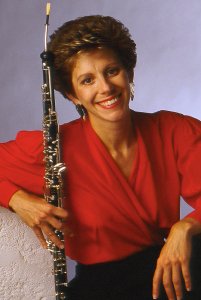 Last year,
Hove played in the premiere of the Concerto for English Horn and Orchestra by the Philharmonic's former timpanist and composer in residence, William Kraft; he also dedicated the piece to her. But although she has recorded two solo CDs,
she observes that "you can't make a career of playing concerti with orchestras the way a percussionist like Evelyn Glennie can. There are solo pieces and a certain amount of concerti, but it's not a mainstream instrument."
Within the context of the orchestra, "we get glorious solos, but then the English horn is also used as an inner voice, the way the French horns are used, or the viola."
Last year,
Hove played in the premiere of the Concerto for English Horn and Orchestra by the Philharmonic's former timpanist and composer in residence, William Kraft; he also dedicated the piece to her. But although she has recorded two solo CDs,
she observes that "you can't make a career of playing concerti with orchestras the way a percussionist like Evelyn Glennie can. There are solo pieces and a certain amount of concerti, but it's not a mainstream instrument."
Within the context of the orchestra, "we get glorious solos, but then the English horn is also used as an inner voice, the way the French horns are used, or the viola."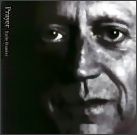 According to
According to